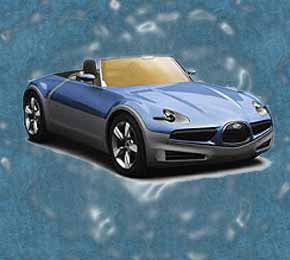|
Subaru
B9 SC Scrambler Hybrid
|
|
The Subaru B9 SC Scrambler
Hybrid is a concept car announced at the 2003 Tokyo Motor
Show. The Subaru two-seat B9 SC roadster hybrid teams
up a high-torque electric motor with a 2.0-liter DOHC
Subaru boxer flat 4-cylinder gasoline engine.
At low to middle speeds,
the B9 Scrambler Hybrid uses the gasoline engine to charge
its bank of high-density manganese lithium-ion (NLE) batteries,
while at higher speeds (above 50 mph) it operates exclusively
with its gasoline engine.
|
The NLE batteries (developed in a joint venture with NEC corporation)
offer greater flexibility than other manufacturer's hybrid batteries
in that with Subaru, battery cells can be added and subtracted
to accommodate different body designs. This will also be useful
if Subaru plans to sell the battery pack to other hybrid manufacturers
as well.
 Pictured
is the Subaru B9 SC Scrambler.
Pictured
is the Subaru B9 SC Scrambler. |
|
The Subaru Scrambler Hybrid uses a special 2-way clutch
in its Sequential Series Hybrid Electric Vehicle (SSHEV)
system to seamless switch between gasoline engine and electric
motor. The all-wheel drive B9 SC Hybrid also rides on air,
adjustable air suspension, that is as it makes allowances
to ground clearance as needed. With the addition of the
Scrambler's large wheels with run-flat tires, it makes this
hybrid car a vehicles for many rough road conditions as
well as highway driving.
The Subaru B9 SC Scrambler Hybrid also offers a dent, scratch,
and ding resistant body including a special protective paint
that also wraps over the upper body and behind the doors
to provide unity to the design. The Scrambler is scrambling
to protect itself from rocks and other road debris with
this new protective coating.
According to the latest reports, the roll out of the Subaru
B9 SC Scrambler Hybrid is being delayed indefinitely. According
to Fuji Heavy, owner of Subaru, the car company has not figured
out yet how to reduce production costs to the point of being
commercially viable. In order to make it to market more quickly,
Subaru has formed an alliance that is to be mutually beneficial.
Toyota will supply Subaru with the hybrid power system
for its new cars and vehicles. Subaru, in turn, will supply
Toyota with the manganese lithium-ion batteries that Toyota
will begin to use in production vehicles. Because Subaru
only brings 590,000 or so vehicles to market, it makes sense
that they delay, abandon or just stretch out the development
costs over a longer period-of-time. In the short-term, however,
Subaru can bring a hybrid car to market more quickly as
the market for this commodity is already heating up and
will get even hotter over the next 5-10 years.
Subaru has also just announced plans to sell an all-electric
minicar in Japan by 2009. The Subaru R1e electric vehicle
is being powered by the same lithium-ion battery pack as
the Scrambler Hybrid is and is designed to run 200 kilometers
(124 miles) on a single charge. The R1e electric minicar
can be charged by plugging it into the same kind of AC outlet
that home air conditioners use.
The Subaru B9 SC Scrambler Hybrid, though a ways off, is
still something to keep on eye on for the future. With its
sleek, sporty design and technical innovations, this one
car could help Subaru's sagging sales breath a new life
for years to come.
|


